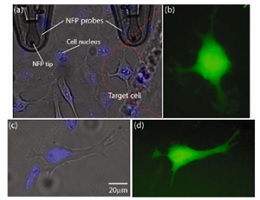 |
| Transfection using nanofountain probe electroporation--Courtesy of Nano Letters |
Researchers at Northwestern University have developed a technique to drill temporary holes in cell membranes to deliver drugs more easily into the cells.
Borrowing from the concept of bulk electroporation, in which holes are created via electric pulses albeit with moderate results, the researchers created a new method called nanofountain probe electroporation (NFP-E), which allows for more localized control over where the pores manifest. And by varying the duration of the electric pulses, delivery--or transfection--can be precisely dosed and timed, according to the research published in the journal Nano Letters.
By targeting a single cell rather than multiple cells at a time, the entire process can be monitored and directed by researchers using an optical microscope. The NFP-E probe itself is a chip with an array of microfabricated cantilever probes with integrated microfluidic channels, according to a Northwestern report, and can deliver such materials as polysaccharides, proteins, DNA hairpins and plasmid DNA.
Lead researcher Horacio Espinosa has plans to develop the system for commercial use by his university spinoff company iNfinitesimal, and expects to make it available by the end of this year.
"This is really exciting," Espinosa said in a statement. "The ability to precisely deliver molecules into single cells is needed for biotechnology researchers to advance the state of the art in therapeutics, diagnostics and drug delivery toward the promise of personalized medicine."
- here's the Northwestern University report
- and here's the Nano Letters article